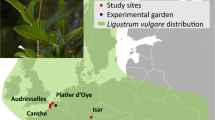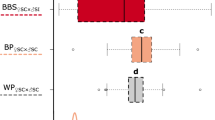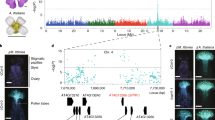Abstract
THE term ‘self-sterile’ is used for describing plants which fail to set self-seed when they are grown in isolation or when they are self-pollinated. Silow1 reviewed the early usage of this term and proposed the term ‘voluntarily self-sterile’ to describe Lotus plants that fail to set seed when isolated from insects and ‘artificially self-sterile’ when they still fail to set self-seed following artificial self-pollination. He observed that several Lotus species in isolation set more self-seed following artificial self-pollination than the same plants without artificial self-pollination. This difference can be accounted for by the presence of a stigmatic membrane which prevents germination and growth of any pollen. This membrane is ruptured by artificial self-pollination or by insect pollination of the flower, after which pollen can germinate and grow. The presence of a stigmatic membrane was observed by Elliott2 in L. tenuis and by Giles3 in L. corniculatus. Giles3 was unable to observe any difference in germination between self- and cross-pollen once the membrane ruptured. The presence of a similar membrane was observed by me4 in several other Lotus species. This membrane can account for the observed voluntary self-sterility and for differences between voluntary and artificial self-sterility, but it does not account for artificial self-sterility.
This is a preview of subscription content, access via your institution
Access options
Subscribe to this journal
Receive 51 print issues and online access
$199.00 per year
only $3.90 per issue
Buy this article
- Purchase on Springer Link
- Instant access to full article PDF
Prices may be subject to local taxes which are calculated during checkout
Similar content being viewed by others
References
Silow, R. A., Welsh Plant Breeding Sta. Bull. (Ser. H), 12, 234 (1931).
Elliott, F. C., “Plant Breeding and Cytogenetics” (McGraw-Hill, New York, 1958).
Giles, W. L., Ph.D. thesis (Univ. of Missouri, 1949).
Bubar, J. S., Can. J. Bot., 36, 65 (1958).
East, E. M., and Manglesdorf, A. J., Proc. U.S. Nat. Acad. Sci., 11, 166 (1925).
Brink, R. A., and Cooper, D. C., Science, 90, 545 (1939).
Pandey, K. K., Amer. J. Bot., 44, 879 (1957).
Dawson, C. D. R., J. Genet., 42, 49 (1941).
Bateman, A. J., Heredity, 10, 257 (1956).
Bolton, J. L., Sci. Agric., 28, 97 (1948).
Author information
Authors and Affiliations
Rights and permissions
About this article
Cite this article
BUBAR, J. Differences between Self-Incompatibility and Self-Sterility. Nature 183, 411–412 (1959). https://doi.org/10.1038/183411b0
Issue Date:
DOI: https://doi.org/10.1038/183411b0
This article is cited by
-
No evidence for Fabaceae Gametophytic self-incompatibility being determined by Rosaceae, Solanaceae, and Plantaginaceae S-RNase lineage genes
BMC Plant Biology (2015)
-
Reproductive biology ofCaesalpinia calycina andC. pluviosa (Leguminosae) of the caatinga of north-eastern Brazil
Plant Systematics and Evolution (1999)
-
Late-acting self-incompatibility in angiosperms
The Botanical Review (1986)
-
Time and site of theS-gene action, breeding systems and relationships in incompatibility
Euphytica (1970)
-
Inheritance of Self-incompatibility and Brown Keel Tip in Lotus corniculatus L.
Nature (1965)
Comments
By submitting a comment you agree to abide by our Terms and Community Guidelines. If you find something abusive or that does not comply with our terms or guidelines please flag it as inappropriate.



